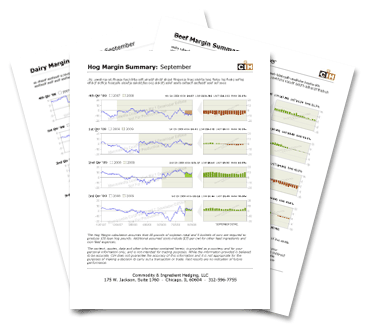Grading Beef What Is an "Usage Ratio" How Is It Used
Margin Watch: February
March 2, 2011 by Chip Whalen
Hog
Margins deteriorated over the past two weeks, most notably in nearby Q1 and Q2. The hog market is in the midst of a correction that is mainly affecting nearby contracts, as weights continue to run higher than year-ago levels. Further, total pork in cold storage was reported up 9.9% from last year, with hams at a 10-year high accounting for 20% of the total pork supply in cold storage. Deferred contracts in summer and fall months are slightly lower, although continued strength is present with those contracts not far from their highs. Feed costs have increased since the middle of February, as demand rationing continues to occur at these high prices amid historically tight stocks. Adding to the upside pressure, Mexico's corn crop experienced a damaging freeze and is estimated to have been a total loss, roughly 165 million bushels. This is expected to cause the need for further imports from the U.S. while the… Get the Complete Report »
Dairy
With the exception of nearby Q1, dairy margins deteriorated over the past two weeks as milk futures experienced a sharp correction since the middle of February while feed costs increased. The milk market has come under pressure from building cheese inventories and higher milk production. USDA reported January all-milk production at 16.385 billion pounds, up 2.3% from a year ago while 50-state cow numbers increased 16,000 head for the second straight month to 9.157 million head, the largest herd size since the summer of 2009. Moreover, production per cow in January was 57.7 lbs. per day, up 0.8 lbs. or 1.5% from the prior year. Meanwhile, USDA's Cold Storage report showed January 31 total cheese inventories at 1.052 billion pounds, up 7% from last year. Feed costs continued moving higher in the second half of February, with USDA's annual… Get the Complete Report »
Beef
Production margins were slightly weaker since the middle of February as corn and feeder cattle prices increased while live cattle prices decreased. The February live cattle contract expired weakly as the cash market has been under pressure. USDA's Cold Storage report showed frozen beef stocks as of January 31 at 460.2 million pounds, up 3.4% from the previous month and 8% higher than last year, although total beef inventories remain seasonally normal. One supportive factor for the market is lower imports from Australia with January shipments down 52% due to the historic flooding in Queensland as well as the stronger Australian dollar and demand from other regions. It is also noted that the historically wide disparity with the percentage of beef grading choice over select may help to strengthen demand in the domestic market. Feeder cattle supplies… Get the Complete Report »
Corn
Margins have improved since the middle of February, as the futures market accounted for the gain. USDA released its baseline projections through the year 2020 during the period. Corn acreage for 2011 is estimated to be 92 million acres, up 3.8 million from 2010, and carryout is projected to rise slightly. The market will discount this estimate until the March 31 Prospective Plantings Report, when the official survey for this year's acreage is published. What the USDA confirmed with their projection is a tight balance sheet for the next few crop years, as demand rationing will be a major chore for the market. Given the currently tight domestic situation, 2011 planting intentions will continue to be the main focus. Meanwhile, Mexico just experienced a freeze that has destroyed its domestic corn crop. Some re-planting is possible; however… Get the Complete Report »
Soybean
Nearby margins are nearly unchanged over the past two weeks, with slightly weaker futures being offset by a slightly stronger basis. USDA released its baseline projections through the year 2020 during the period. Soybean acreage for 2011 is estimated to be 78 million acres, up 0.6 million from 2010, and carryout is projected to rise slightly. The Prospective Plantings Report that will be released at the end of the month will be used to confirm this estimate. USDA estimates that ending stocks, as well as the stock-to-usage ratio will remain historically tight for the remainder of the decade. The weekly export sales data has added volatility to the market, as China canceled several cargoes of soybeans due to more competitive South American prices. This trend is concerning; however, sales remain on pace to meet the USDA estimate. Meanwhile, the Brazilian harvest is 19% complete versus 26% a year ago, as rains have kept farmers out of the fields. Private forecasts have… Get the Complete Report »
Wheat
Margins deteriorated since the middle of February, with both the nearby and deferred margins down slightly. News during the period has been thin, as the focus is on row crops. However, the Mideast continues to see civic unrest as countries have begun to protest current governments. The recent conflict is centered on Libya, and has energy markets on edge. This has kept a premium bid on corn, as over 35% of the domestic U.S. crop is used for ethanol, and has pushed the spot wheat/corn relationship to multi-year lows. If this trend continues, the market may begin to price in some switch in feed demand from corn to wheat. The U.S. Plains have received beneficial moisture recently, and crop conditions will be monitored closely as the winter crop comes out of dormancy. It is important to note that this year's crop entered dormancy at one of the lowest… Get the Complete Report »
About the Author

Chip Whalen
Chip is one of our resident educators with over fifteen years of teaching, trading, and senior risk management experience.
There is a risk of loss in futures and options trading. Past performance is not indicative of future results. The information contained in this publication is taken from sources believed to be reliable, but is not guaranteed by Commodity & Ingredient Hedging, LLC, nor any affiliates, as to accuracy or completeness, and is intended for purposes of information and education only. Nothing therein should be considered as a trading recommendation by Commodity & Ingredient Hedging, LLC. The rules and regulations of the individual exchanges should be consulted as the authoritative source on all contract specifications and regulations.

Get the Full Report
We'd be happy to deliver the complete, bi-weekly CIH Margin Watch report to your email box. Subscribing is quick and easy:
About CIH
We provide customized agricultural price management consulting services and educational programs to livestock and crop producers, food and feed companies, milling, crushing, and trading firms.
We pride ourselves on the ability to work one-on-one with clients, allowing them to gain greater expertise and confidence in managing price risk and controlling margins.
Source: https://www.cihedging.com/margin-watch-notes/2011-february/
0 Response to "Grading Beef What Is an "Usage Ratio" How Is It Used"
Enviar um comentário